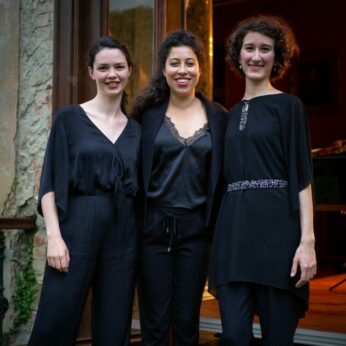Composer: Johannes Brahms (b. 1833 - d. 1897)
Performance date: 26/06/2022
Venue: Bantry House
Composition Year: 1886
Duration: 00:21:52
Recording Engineer: Eduardo Prado, Ergodos
Instrumentation: vn, vc, pf
Instrumentation Category:Piano Trio
Artists:
Mairead Hickey -
[violin]
Nathalia Milstein -
[piano]
Ella van Poucke -
[cello]

Johannes Brahms [1833-1897]
Piano Trio No.3 in C minor Op.101 [1886]
1. Allegro energico
2. Presto non assai
3. Andante grazioso
4. Allegro molto
Brahms enjoyed taking summer holidays in various attractive resorts. There he would find the time to write his music, away from his busy Viennese life. In 1886 he chose Hofstetten on picturesque Lake Thun in central Switzerland. It proved a particularly productive summer as he completed not only this fine Trio but also his Violin Sonata in A and the F major Cello Sonata. Brahms tried the work out in Budapest that December and the official première took place in Vienna with Brahms and members of the Heckmann Quartet on February 26th 1887.
This is a remarkable creation among Brahms’s chamber music in that all the movements are quite short and the musical ideas concentrated into unusually brief time spans. Part of this brevity is due to the fact that Brahms uses a three-note format extensively, rather than any of the long, romantic melodies usually associated with him. The first movement opens dramatically with a commanding phrase led by the piano, indeed much of the Trio is derived from its three-note motto. Following some staccato comments on it, the cello introduces the main melody, which is shared around the instruments, though the motto idea is never far away. It is a short movement and the development of the material is brisk and workmanlike. Even the recapitulation skips the main theme and the coda is just a few abrupt chords. The second movement is a fleeting intermezzo involving a running piano phrase with comments from the strings. The short central sequence involves a distinctive cello pizzicato phrase but the music soon returns to the flurry of its opening and a sudden end.
The gracious third movement has an odd time signature: “3/4 + 2/4 + 2/4”. In essence there are seven beats in the bar, creating a long-flowing melody launched by the piano. The strings add their comments but the piano tends to dominate particularly in the brief, slightly faster, central section. A meditation on the first part follows to round off this movement, with the piano adding a strong full stop. The finale is vigorous with further variants of the three-note idea from the first movement for both of its main themes. Marked very fast it thunders along without any hesitations to a robust conclusion. In a letter to his friend Elizabeth von Herzogenberg he commented I should think the Trio’s finale requires, first very careful handling, and then the reverse!
Ian Fox
Copyright © 2024 West Cork Music. All rights reserved.
Designed and developed by Matrix Internet